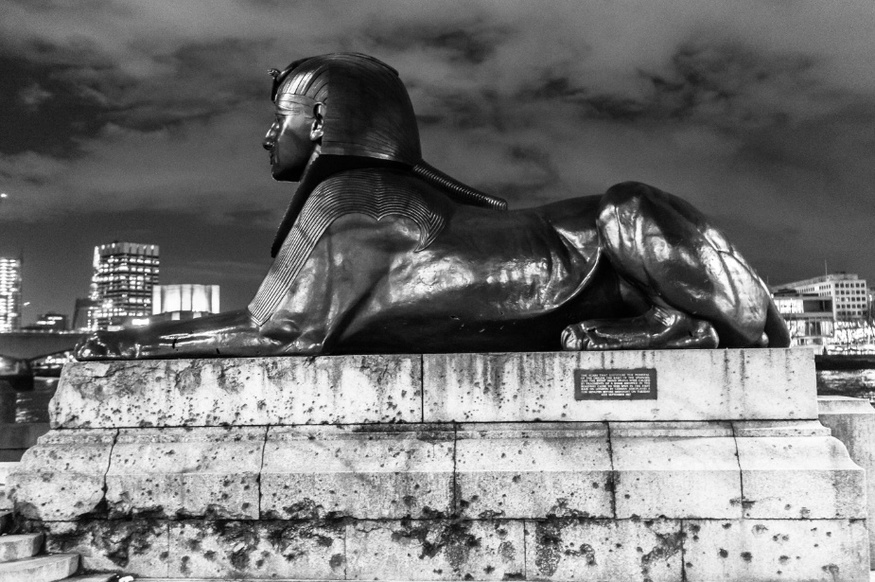Beneath London's soil, and some of its iconic landmarks, are boxes containing a snapshot of the past.

Cleopatra's Needle (buried 1878)
The Victorians planted a time capsule beneath Cleopatra's Needle when it was eventually installed on Embankment in 1878. In it are children's toys, a razor, copies of the bible, a Bradshaw Railway Guide, 12 portraits of 'pretty ladies' (hand selected by Captain Henry Carter, who helped ship the needle to London) and a painting of Queen Victoria. The latter is by Louis Le Prince, who it's said shot the world's first film, and whose mysterious death, some believe, had something to do with rival Thomas Edison.
Just to the south-west of Cleopatra's Needle, another time capsule is buried — this one, beneath the RAF Memorial, was erected in 1923. The box, filled with first world war memorabilia, is fashioned from the remains of a downed Avro Lancaster, in which all crew members were killed.

South Bank Lion (reburied 1966)
The Coade stone beast that oversees Westminster Bridge has a secret up its behind; two William IV coins and a Coade trade card were discovered in a cavity in the statue when it was removed from its original stance on top of a South Bank brewery. In 1966, when installed into its current position, the lion accrued a few more nostalgic trinkets. It's all sealed up though, so no point going sniffing around.
The O2 (buried 1998)
Historically, the Blue Peter team has a canine-like enthusiasm for burying things in gardens. Their obsession began in 1971, when John Noakes, Valerie Singleton and Peter Purves buried a capsule — containing a Blue Peter annual and a set of decimal coins — in the famous Blue Peter garden, White City. A second time capsule was buried alongside it in 1984. When these two were dug up in 2000 (in all their sopping wet, mulchy glory), a third time capsule was buried in their place.
It seems all those time capsules are now at the new Blue Peter HQ in Salford. But there is another Blue Peter time capsule — containing a Blue Peter badge, a Teletubbies doll and an insulin pen — which was buried beneath The O2 (then Millennium Dome) by presenters Katy Hill and Richard Bacon in 1998. It'll next see the light in 2050, assuming Blue Peter's still on the air.
Meanwhile, on the site of 1951's version of the Dome (aka the Festival of Britain's Dome of Discovery, now Jubilee Gardens) is another time capsule. In it are items from British Rail, Electolux and, er, Arthur C Clarke.
As for the former Blue Peter garden at White City; that remains something of a grizzly time capsule in its own right. It's the final resting place of many a Blue Peter pet, including George the tortoise.
Wembley Stadium (buried 2005)
Sketches of the Wembley arch by architect Norman Foster, a signed England shirt and a chunk of the stadium's demolished twin towers, are buried beneath the hallowed turf at Wembley Stadium. We'd like to see the time capsule dug up at half time in front of 90,000 fans.

Tottenham Court Road station ('buried' 2014)
Perhaps having learned from Blue Peter about the perils of burying your time capsule in soil, Transport for London went about doing theirs a different way. To mark 150 years of the London Underground, a box containing an Oyster card, copies of the Metro and Standard, a pair of moquette trainers and a Baby on Board badge, went on display behind a glass case at Tottenham Court Road station. Commuters can view the box, and — although you can't actually see inside — appreciate that it's made from a salvaged District line signalling box.
Blogger Ian Visits imagined the reopening of the capsule in 2063 by the God Emperor of the Known Londonverse.

Other time capsules
Beneath the new Design Museum in Kensington is planted a bizarre concoction of objects, including an iPhone, a bottle of Burgundy, a light bulb, an image of Battersea Power Station, and a tin of anchovies (the fishy choice of designer Sir Terence Conran).
We also know of capsules beneath the Wellcome Trust (see image above), Bush House, its neighbour Australia House and the London School of Economics. They all contain the predictable choice of coins.
Some time capsules are rather more niche; one belonging to BT was unearthed from a former BT building in Islington in 2016, 58 years after it was buried. Inside was a "700-type telephone handset, a polythene-covered subscribers' cable that reduced corrosion, a Telex-answerback unit... and a 3000-type standard relay" (and you thought a Blue Peter annual sounded dull).

If you'd like to stretch the definition, you might count like likes of Dennis Severs' House, 18 Stafford Terrace and Sir John Soane's Museum as walk-in time capsules.
And who knows what other purposefully-planted secrets the London earth holds; according to The International Time Capsule Society, around 90% of time capsules are never relocated. Let's keep on digging, London.
Additional information from Matt Brown.




